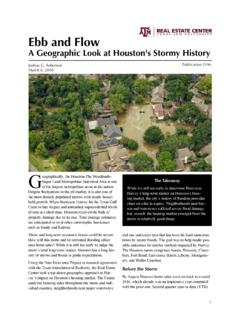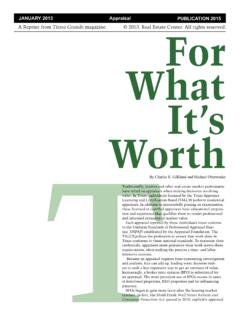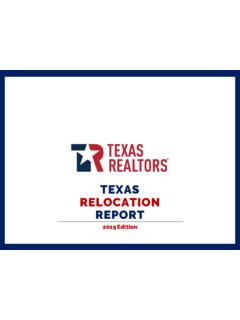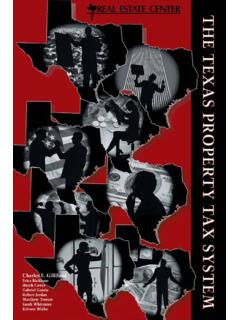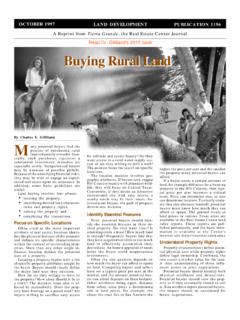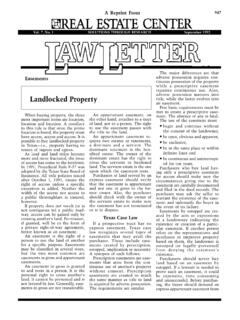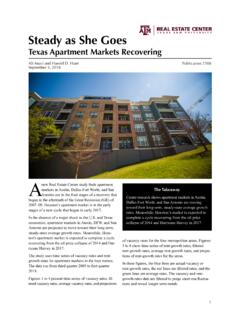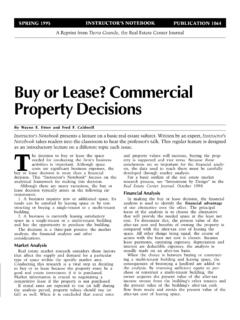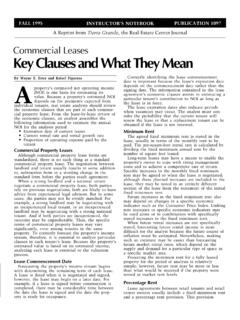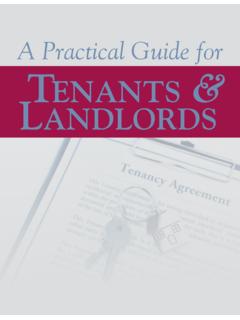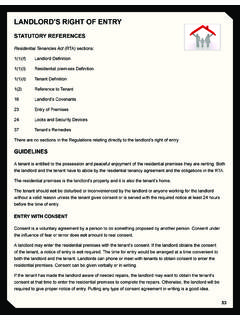Transcription of LANDLORDS AND TENANTS
1 SPECIAL REPORTREVISED SEPTEMBER 2016866 LANDLORDSG U I D ENo_JUDON FAMBROUGHTENANTSAND_Addendum with updates added March 2019E .V. RUSTY ADAMS IIIATTORNEYS AT LAWJ udon Fambrough Attorney at LawLandlords and TENANTS GuideRevised September 2016 2019, Real Estate Center. All rights contained in this document is current as of September 2016. An addendum has been included to address changes through March 2019. Portions may now be out of date because of changes in laws, rules, market conditions, or other factors. Real Estate Center publications are for information only. They are not a substitute for legal, tax, or other professional advice. Addendum by "Rusty" Adams III Attorney at LawForewordResidential landlord 's Duty to RepairRetaliationResidential landlord 's Duty to Return Security DepositsRental ApplicationResidential landlord 's Duty to Install, Inspect, and Repair Smoke Alarms and Fire Extinguishers Residential landlord 's Liability for Utility Cutoffs and Interruptions Miscellaneous landlord - tenant Topics Charging Late Fees Providing Emergency Phone Number Guarantor's Liability When Lease Renewed Advance Notices for Terminating Leases Termination of Leases for Criminal Conviction TENANTS ' Lien Subletting and Finding Replacement TENANTS TENANTS ' Insurance TENANTS ' Right to Protest Property Taxes TENANTS ' Right to Summon Police TENANTS ' Right to Terminate Lease for Family Violence TENANTS ' Right to Terminate Lease for Sexual Offenses Lease Term Following Natural Disaster TENANTS ' Right to Terminate Lease for Military Service landlord 's Duty to Provide Copy of Lease landlord 's Liability for Leasing to Person with Criminal Record TENANTS ' Remedies When Certificate of Occupancy Revoked Notice of Utility Disconnection to Nonsubmetered Master
2 Metered Multifamily PropertyGeneral Provisions Relating to the Residential landlord - tenant Relationship landlord 's Agents and Agent's Liability Bad Faith and Harassment Waivers and Venue Cash Rental Payments Occupancy Limits for Adults landlord 's Duty to Mitigate Damages Notices Sent to tenant 's Primary Residence Policy Changes by landlord Care of Deceased tenant 's Personal Property and Security DepositRemoval of Property and LockoutsResidential landlord 's Duty to Install and Maintain Security DevicesResidential landlord 's Duty to Disclose Ownership and Management of Rental UnitPublic Nuisances at Multiunit Residential PropertyContentsiii191115172227364043505 2iCommon Nuisances Occurring at Multiunit Residential PropertyResidential landlord 's LienLandlord's Right to Evict TENANTS Procedure and Jurisdiction for Evictions Writ of Possession Appealing an Eviction Pauper s Affidavit Payment of Rent During an Appeal for Eviction Issuing a Writ of Possession Executing the Writ of Possession Removal and Care of Personal Property Warehouseman s LienCovenant for Quiet Enjoyment and Constructive EvictionResidential Rental Locators Telecommunications Swimming Pool EnclosuresPool Yard Enclosures with Relevant DefinitionsAscertaining the Criminal History of Employees of Residential Dwelling Projects with Relevant DefinitionsTowing Vehicles from Parking Lots and Public Roadways Rules for Towing Vehicles from Multiunit Complexes' Parking Lots with Relevant DefinitionsFederal and State Statutes Affecting Residential and Commercial Tenancies Soldiers' and Sailors' Civil Relief Act of 1940 Fair Housing Amendments of 1988 Pesticide Application Warning of Lead-based Paint or Hazards Statute of Frauds Contract Addendum for Disclosure of Information on Lead-based Paint HazardsCommercial
3 TenanciesSubmetering Commercial PropertyLandlord s Lien on Commercial BuildingsSelf-Service Storage Facility LiensMediation with Sample AgreementGlossaryAddendumThis report is for information only; it is not a substitute for legal property plays a major role in Texas real estate. Central to much of this property is the landlord - tenant relationship. Significant legisla-tive changes have been made in recent years. One basic rule of English common law was that a tenant s duty to pay rent was independent of the landlord s duty to repair without an agreement or statute to the contrary. The lease was regarded as a conveyance in land, subject to the doctrine of caveat emptor ( let the buyer beware ). The landlord was required to deliver only the right of possession. The tenant , in return, was required to pay rent as long as possession was retained, even if the building was destroyed or became uninhabitable.
4 Texas courts and legislators have attempted to soften the harshness of this rule. The first major relief came in 1978, when the Texas Supreme Court established an implied warranty of habitability on residential LANDLORDS (Kamarath v. Bennett, 568 2d 658 [Tex. 1978]). In 1979, Texas legislation effectively extinguished the implied warranty by enacting Subchapter B of Section 92 of the Texas Property Code. As stated in that subchapter, the law replaced existing common law (case law) and other statutory law, warranties and duties of residential LANDLORDS for maintenance and repair of rental units. More changes were enacted in 1993. Most signifi-cant was the replacement of subchapter D with new provisions requiring the installation of certain secu-rity devices in residential units. The failure of the landlord to comply allows the tenant to unilaterally terminate the lease. Also, another new law permits employers in multiunit complexes to inquire about Forewordiiiand verify the criminal history of current and pro-spective employees.
5 In 1995, new laws were added concerning the licensing of residential rental locators, the abate-ment of nuisances at multiunit residential property, the installation of telecommunications equipment on rental property and required educational courses dealing with landlord - tenant issues. In 1997, the 75th Legislature required LANDLORDS to mitigate damages when a tenant moves out early. Also, the legislators raised the maximum amount for the repair-and-deduct statutes to $500 or one month's rent, whichever is greater. This report discusses the various subchapters of the Texas Property Code, the Texas Local Govern-ment Code, the Texas Health and Safety Code, the Texas Human Resources Code, the Texas Govern-ment Code, the Texas Civil Practices and Remedies Code and also Articles 6701g-2 and 6573(a) of the Texas Civil Statutes as amended, as each applies to residential and commercial tenancies. Because of the number of recent amendments, many sections lack case law to construe and clarify meaning and application.
6 This is particularly true of laws dealing with security devices, pool yard en-closures and towing vehicles. To make the statutes more understandable, the language has been changed to lay terms when possible. LANDLORDS and TENANTS alike should be aware of the current statutes. For LANDLORDS , the awareness is critical; knowledge helps avoid liability. TENANTS , on the other hand, need to know the law so they can preserve, protect and claim their rights and landlord s Duty to Repair or Close Leasehold Subchapter B, Chapter 92, Texas Property Code Subchapter B is significant to residential LANDLORDS and TENANTS . Under the former implied warranty of habitability, the landlord was obligated to make the premises habitable throughout the lease term. The duty arose automatically without the tenant taking any initiative. However, under the present legislative standard, the tenant must inform the landlord of a problem before the repair obligation arises.
7 Each section of Subchapter B is discussed in the order that it appears in the statutes, beginning with Section and ending with Section The focus is primarily on what the landlord must repair, what the tenant must do to invoke the landlord s duty to repair and what the tenant s options are if the landlord fails to statutes addressing landlord retaliation, Sec-tions and , have been moved to Sub-chapter H, Sections through , effective January 1, leases are affected?The subchapter affects all residential leases execut-ed, entered, renewed or extended on or after Septem-ber 1, 1979 (Section ). Obviously, amendments added after 1979 became effective as specified by the enabling legislation. Which conditions must LANDLORDS repair?Section [b] sets the basic premise for the subchapter. The landlord must make a diligent effort to repair or remedy any condition when: the tenant has specified the condition in a notice to the person who collects rent or to the place where the rent is normally paid, the tenant is current in rent payments when the notice is given, and the condition:1) materially affects the health or safety of an ordinary tenant or 2) arises from the landlord 's failure to provide and maintain in good operating condition a device to supply hot water of a minimum temperature of 120 degrees notice must be in writing only if the written lease so requires.
8 As a practical matter, all notices should be in writing and either delivered in person or sent by certified mail, return receipt requested. Otherwise, proving that notice was served may be difficult. If delivered, some verification such as a witness or a written acknowledgment from the re-cipient is needed. How do TENANTS know who to contact for repairs? LANDLORDS who have on-site management or a superintendent s office for residential rental prop-erty must provide a 24-hour telephone number for reporting emergencies on the leased premises that materially affect the physical health or safety of an ordinary tenant . The number must be posted outside the management or superintendent s office (Sections [a]&[b]).What about LANDLORDS in other situations? LANDLORDS who do not have on-site management or a superintendent s office must provide TENANTS a telephone number for reporting emergencies on the leased premises that materially affect the physi-cal health or safety of an ordinary tenant (Section [d].)
9 The manner by which the information must be provided is not specified in the statute. Are there any exceptions to the rules?Yes. The rules do not apply to or affect a local ordi-nance governing a landlord s obligation to provide a 24-hour emergency contact number if the ordinance was adopted before Jan. 1, 2008, and if it conforms with or is amended to conform with the require-ments of the statute (Section [c]).Which conditions need not be repaired by the landlord ? Unless the problem is caused by normal wear and tear, the landlord has no duty to repair conditions caused by: the tenant a lawful occupant of the apartment a member of the tenant s family a tenant s guest or inviteeFinally, the landlord is not required to furnish utilities from a utility company if the utility lines are not reasonably available. The landlord is not re-quired to furnish security guards (Section [b]).
10 The phrase normal wear and tear is defined as deterioration that results from the intended use of a dwelling .. but the term does not include dete-rioration that results from negligence, carelessness, accident or abuse of the premises, equipment or chattels by the tenant , by a member of the tenant s household, a guest or invitee of the tenant (Texas Property Code, Section [4]).2 Who has the burden of proof? Normally, in a judicial proceeding, the tenant must prove that the landlord failed to repair or rem-edy a condition that materially affects the health or safety of an ordinary tenant (Section ). How-ever, the landlord must assume this burden if the tenant can show that reasonable time has elapsed since the initial notice to repair was given, a subsequent written notice was given to the landlord demanding an explanation for the de-lay, and the landlord failed to make the repairs or give a written explanation for the delay within five days after the second demand notice was received.

